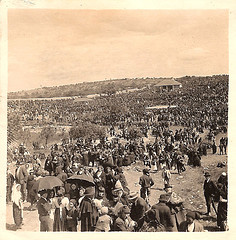Fatima for Today: The Urgent Marian Message of Hope
Fr. Andrew Apostoli
Before I became Catholic three years ago, I had never heard a single thing about Fatima. But now I hear it mentioned all the time. Here’s the basic background:
In 1917, three young children were visited six times by Mary in Fatima, Portugal. Through her appearances and messages, Our Mother asked the children for increased prayer, devotion, and repentance on behalf of the world. She also reinforced the primacy of the Rosary and provided three ‘secrets’–three prophetic visions that unfolded over time.
 |
| People watching the ‘Miracle of the Sun’ |
Now I know that may seem unbelievable at first glance, as it did to me when I first discovered it. But there’s one more twist that may cause you to reconsider.
At the climax of the visions, in order to prove their authenticity to skeptics, Mary induced “The Miracle of the Sun“, an unexplained phenomenon witnessed by 80,000 people–including many atheists–some more than ten miles away. The sun appeared as an “opaque, spinning disc in the sky” and “careened to earth in a zig-zag pattern”, striking terror in most witnesses.
That’s the basic outline, but a new book by Fr. Andrew Apostoli titled Fatima for Today:The Urgent Marian Message of Hope (Ignatius Press, hardcover, 288 pages) goes much deeper and has positioned itself to be the best introduction to all things Fatima.
In the book, Apostoli breaks down each of Mary’s messages and explores their significance for our own time. He also covers many different interpretations of the messages from popes, saints, and theologians over the past century. In fact, Pope Benedict XVI’s own interpretation, which he wrote while heading the Congregation for the Doctrine of the Faith, is included in the book’s Appendix in full.
Interestingly, Fr. Apostoli is not only a Fatima expert but also the vice-postulator for the saintly Cause of Archbishop Fulton Sheen, one of my great heroes. In this book, Apostoli highlights many of Sheen’s own thoughts on Fatima including one of his most insightful connections.
Sheen always surmised that Fatima would eventually act as a great bridge between Christians and Muslims.
He explains that before it was a town, Fatima was the name of the daughter of Muhammad, the founder of Islam. It was also the name of a Muslim princess in Portugal who converted to Catholicism, which is how the town got its name.
According to Sheen, these connections are important. That Our Lady appeared in the only village in Portugal that bears a Muslim name is a sign of hope that through her, many Muslims will convert to Christ.
If you’re interested in the Fatima visions, the controversial ‘three secrets’, or the significance and meaning of Mary’s messages, Fatima for Today provides a great overview. It’s very well-written and I recommend it as the premier one-stop guide to Fatima.


